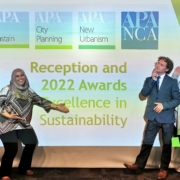What It Means to Plan for Net-Zero
With the heat dome hitting the Pacific Northwest this summer, extreme floods in Europe and Asia, and record temperatures in Siberia, the climate crisis is top of mind for many in North America and beyond.
Critically, we already have solutions to limit global warming. The key is to implement them rapidly and on a huge scale.
This is the point underscored by the Roadmap to Low-Carbon Operations in the National Capital Region, a marquee project we worked on for the Government of Canada The recently released report, which we prepared with Rocky Mountain Institute and whatIf? Technologies, shows the Canadian government can nearly eliminate emissions from its operations, including over 2,200 buildings spanning 60 million square feet (5.6 million square metres) of floor area, as well as corporate fleets, district energy systems, and employee commuting. Canada is implementing many of the findings of the Roadmap through the Greening Government Strategy and PSPC’s Sustainable Development Strategy.
Our analysis shows that the Canadian government has a viable pathway to achieve net-zero emissions, while creating 46,000 person-years of direct employment and 22,000 person years of indirect employment—an average of 1,500 direct and 700 indirect person-years annually. Not to mention improvements in air quality, more comfortable buildings, and increased employee well-being.
What’s more, Canada can do it all with existing technologies while saving money. Transitioning away from fossil fuels via the actions outlined in the pathway, such as electrification of Canada’s fleet, retrofitting old buildings, implementing greener building standards, and more, has the potential to save the Canadian government $900 million by 2050 relative to a status quo future.
We want to ensure that businesses and governments around the world, especially large ones with thousands of buildings, employees, and vehicles, can learn from Canada’s approach. To help get started, we’ve pulled out key insights from the project in a series of four blogs.
1) We need standard, scalable retrofit approaches so we can quickly decarbonize thousands of buildings.
Old, leaky buildings are a climate problem. For organizations with large building portfolios, this challenge is paramount to reducing emissions. And it’s a critical one for solving the climate crisis. According to the UN Environment Programme, buildings account for 36 percent of total global carbon emissions and 39 percent of energy-related carbon dioxide emissions.
One-off retrofits, which are the norm in the building retrofit market, do not capture economies of scale. As a part of our Roadmap development we explored how industrialization and mass customization can take energy efficiency retrofits to scale. The first blog in our series explores the implications of this proposal and the savings it could create.
2) Combining electrification with deep retrofits can cut emissions without crashing the grid.
In the face of the climate crisis, organizations are looking to electrification and renewable energy as a way to get buildings, energy systems, and vehicles off of fossil fuels. But fears abound that plugging too many things into the grid could overwhelm the system and lead to blackouts. Our analysis and modelling for the Roadmap suggests that, by combining electrification with deep energy efficiency retrofits, we can stave off an increase in building-level electricity demand and demand peaks on the electric grid. In our second blog, we explain how.
3) Aging infrastructure is a huge, hidden opportunity for climate action.
Our work found that upgrading aging infrastructure is a cost-effective way to take climate action. More than half of the total federal building area in the Canadian capital will be classified as being in poor or critical condition within the next decade. With smart investments in energy efficiency retrofits, renewable energy, and district energy systems, the federal government can ensure that upgrades to these buildings significantly reduce emissions. The third blog in our series breaks down this historic opportunity for climate action and renewal.
4) We can reduce emissions by modernizing office spaces and changing how people get to work.
Getting to net-zero requires changes in how federal employees work and move. The Roadmap recommends the federal government accommodate teleworking from home and co-working, which can offer employees more flexibility while also reducing transportation emissions. Changes to working life during the pandemic have already shown us that this is possible. In the final blog, we explore the implications of employee commute changes, remote work, and space modernization for climate emissions.
For more insights on how to build a carbon-free future, sign up for the monthly SSG Newswire and updates from the Rocky Mountain Institute’s Carbon-Free Buildings Team.












Trackbacks & Pingbacks
[…] SSG surveyed each area from 2,200 federal buildings that vary Gothic-style parliament buildings built in the mid-19th century brand new LEED-compliant office buildings that are already energy efficient. It found that it was possible to change the administrative buildings in the area net emissions. […]
Comments are closed.